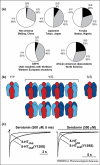3B but which 3B and that's just one of the questions: the heterogeneity of human 5-HT3 receptors
- PMID: 18597859
- PMCID: PMC4116748
- DOI: 10.1016/j.tips.2008.06.001
3B but which 3B and that's just one of the questions: the heterogeneity of human 5-HT3 receptors
Abstract
The 5-hydroxytryptamine 3 (5-HT3) receptor is expressed widely in the central and peripheral nervous systems, where it mediates or modulates a wide range of physiological processes. The receptor is targeted by drugs administered for nausea and/or emesis and irritable bowel syndrome and has been proposed as a potential drug target in various psychiatric disorders. The 5-HT3 receptor is a pentameric ligand-gated ion channel and belongs to the Cys-loop receptor family. In contrast to the immense heterogeneity characterizing other Cysloop receptors, native 5-HT3 receptors historically have been considered a much more homogenous receptor population. However, the recent discovery of additional 5-HT3 subunits and the dawning realization that central and peripheral 5-HT3 receptor populations might comprise several subtypes characterized by distinct functional properties has emphasized the complexity of human 5-HT3 receptor signaling. In this review potential implications of these findings and of the entirely new layer of interindividual diversity introduced to the 5-HT3 receptor system by genetic variations will be outlined.
Figures



Similar articles
-
Natural compounds boldine and menthol are antagonists of human 5-HT3 receptors: implications for treating gastrointestinal disorders.Neurogastroenterol Motil. 2014 Jun;26(6):810-20. doi: 10.1111/nmo.12334. Epub 2014 Apr 8. Neurogastroenterol Motil. 2014. PMID: 24708203
-
5-HT3 receptors.Curr Pharm Des. 2006;12(28):3615-30. doi: 10.2174/138161206778522029. Curr Pharm Des. 2006. PMID: 17073663 Free PMC article. Review.
-
Do polymorphisms in the human 5-HT3 genes contribute to pathological phenotypes?Biochem Soc Trans. 2006 Nov;34(Pt 5):872-6. doi: 10.1042/BST0340872. Biochem Soc Trans. 2006. PMID: 17052218
-
Therapeutics of 5-HT3 receptor antagonists: current uses and future directions.Pharmacol Ther. 2011 Jun;130(3):338-47. doi: 10.1016/j.pharmthera.2011.02.003. Epub 2011 Feb 26. Pharmacol Ther. 2011. PMID: 21356241 Free PMC article. Review.
-
Phylogenetic analyses of 5-hydroxytryptamine 3 (5-HT3) receptors in Metazoa.PLoS One. 2023 Mar 1;18(3):e0281507. doi: 10.1371/journal.pone.0281507. eCollection 2023. PLoS One. 2023. PMID: 36857360 Free PMC article.
Cited by
-
Functional genetic variants that increase synaptic serotonin and 5-HT3 receptor sensitivity predict alcohol and drug dependence.Mol Psychiatry. 2011 Nov;16(11):1139-46. doi: 10.1038/mp.2010.94. Epub 2010 Sep 14. Mol Psychiatry. 2011. PMID: 20838391 Free PMC article.
-
High-affinity fluorescent ligands for the 5-HT(3) receptor.Bioorg Med Chem Lett. 2012 Jan 15;22(2):1151-5. doi: 10.1016/j.bmcl.2011.11.097. Epub 2011 Dec 1. Bioorg Med Chem Lett. 2012. PMID: 22189135 Free PMC article.
-
Discovery of a novel allosteric modulator of 5-HT3 receptors: inhibition and potentiation of Cys-loop receptor signaling through a conserved transmembrane intersubunit site.J Biol Chem. 2012 Jul 20;287(30):25241-54. doi: 10.1074/jbc.M112.360370. Epub 2012 May 15. J Biol Chem. 2012. PMID: 22589534 Free PMC article.
-
VUF10166, a novel compound with differing activities at 5-HT₃A and 5-HT₃AB receptors.J Pharmacol Exp Ther. 2012 May;341(2):350-9. doi: 10.1124/jpet.111.190769. Epub 2012 Feb 3. J Pharmacol Exp Ther. 2012. PMID: 22306960 Free PMC article.
-
Structure, Function and Physiology of 5-Hydroxytryptamine Receptors Subtype 3.Subcell Biochem. 2021;96:373-408. doi: 10.1007/978-3-030-58971-4_11. Subcell Biochem. 2021. PMID: 33252737 Review.
References
-
- Jensen AA, et al. Neuronal nicotinic acetylcholine receptors: structural revelations, target identifications and therapeutic inspirations. J. Med. Chem. 2005;48:4705–4745. - PubMed
-
- Whiting PJ. GABA-A receptor subtypes in the brain: a paradigm for CNS drug discovery? Drug Discov. Today. 2003;8:445–450. - PubMed
-
- Lynch JW. Molecular structure and function of the glycine receptor chloride channel. Physiol. Rev. 2004;84:1051–1095. - PubMed
-
- Chameau P, van Hooft JA. Serotonin 5-HT3 receptors in the central nervous system. Cell Tissue Res. 2006;326:573–581. - PubMed
Publication types
MeSH terms
Substances
Grants and funding
LinkOut - more resources
Full Text Sources
Molecular Biology Databases

